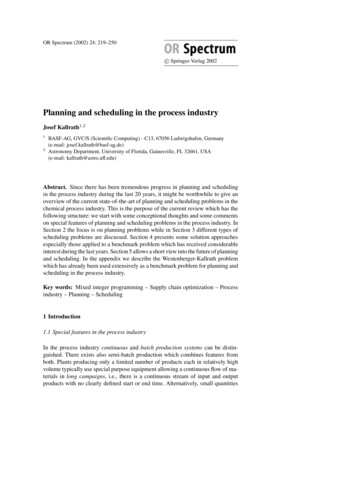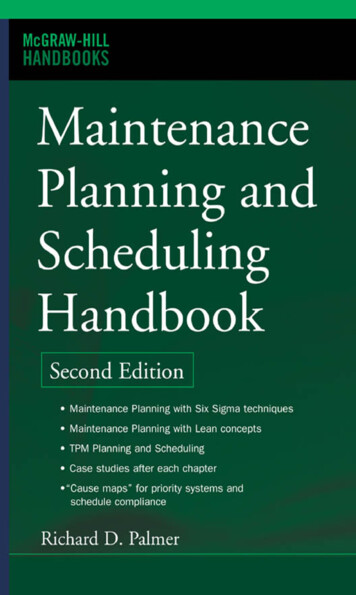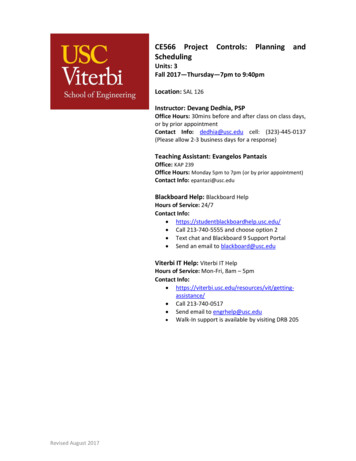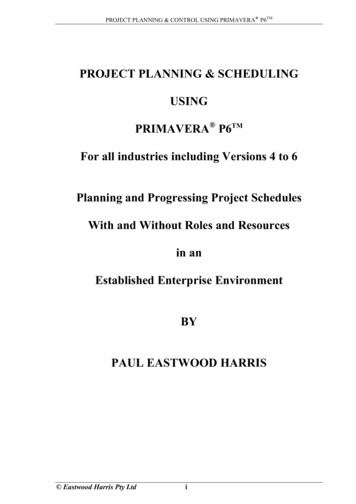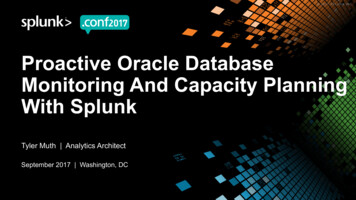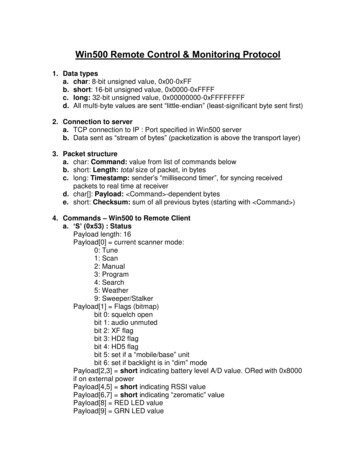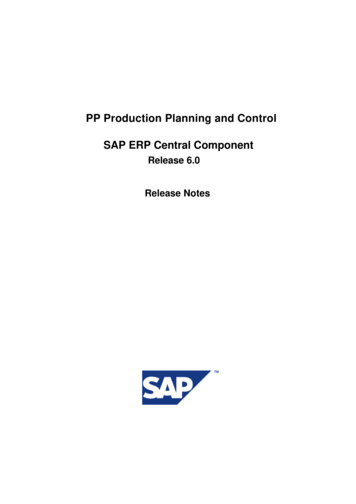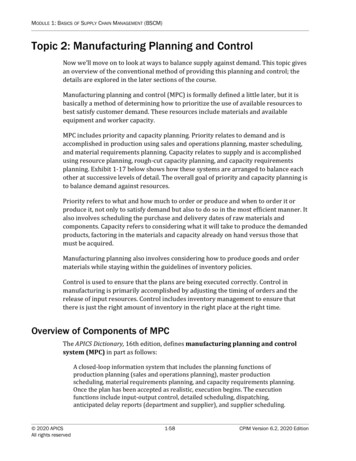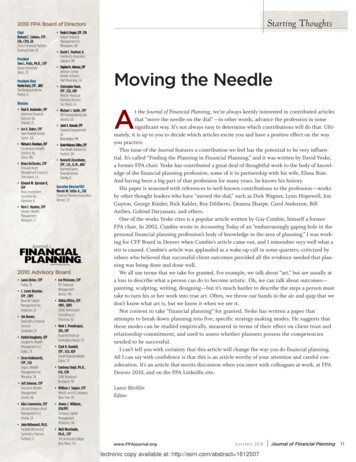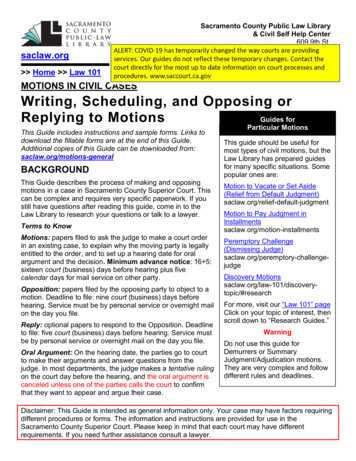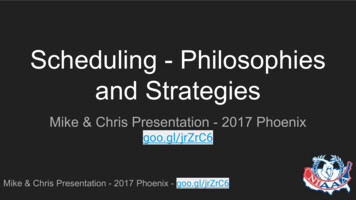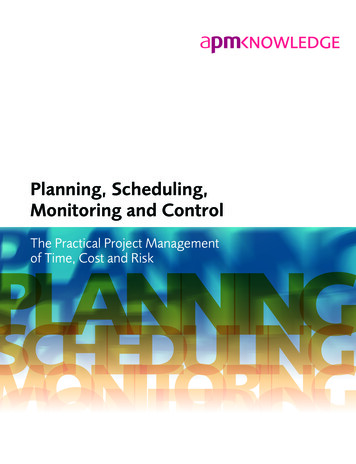
Transcription
Planning, Scheduling,Monitoring and ControlThe Practical Project Managementof Time, Cost and Risk
ContentsList of figures and xxviiiPeer reviewxxxPurposexxxiThe PSMC process mapxxxii1 Overview1.1 Part One: Definition1.2 Part Two: Planning1.3 Part Three: Scheduling1.4 Part Four: Monitoring and control1.5 Part Five: Record keeping and learn ing1.6 A note on the Contents, Index and Gloss ary1.7 Management issues1.7.1 Behaviour and resources1.7.2 Processes and tools (schedul ing soft ware)1.7.3 Common sensePart One: Definition1123467778892 Business case2.1 Definition of the busi ness case2.2 Purpose of a busi ness case2.3 Contents of the busi ness case2.3.1 Structure of the busi ness case2.3.2 Planning inform a tion2.3.3 Funding require ments2.3.4 Resource require ments2.4 Acceptance criteria in the busi ness case2.5 Benefits real isa tion in the busi ness case2.6 Procurement strategy2.7 Project review and assur ance process of the busi ness casev111111121215161616171719
Contents3 Scope manage ment3.1 Definition of scope manage ment3.2 Purpose of scope manage ment3.3 The scope manage ment process3.3.1 Defining the scope3.3.2 Describing the scope2121212222224 Requirements manage ment4.1 Definition of require ments manage ment4.2 Purpose of require ments manage ment4.3 Process of defin ing require ments4.3.1 Requirement descrip tion4.3.2 Factors to consider when defin ingrequire ments4.3.3 Inputs into require ments manage ment4.4 The require ments manage ment process4.4.1 Capture and define require ments from allstake hold ers4.4.2 Link require ments to the product break downstruc tures and work break down struc tureswhere appro pri ate4.4.3 Decompose require ments4.5 Works inform a tion (WI)4.6 Statement of work (SOW)25252525265 Stakeholder management5.1 Definition of stake holder manage ment5.2 Purpose of stake holder manage ment5.3 Managing stake hold ers through the project313131316 Project famil i ar isa tion33Part Two: Planning2627272727282930357 Introduction to plan ning7.1 Definition of plan ning7.1.1 Definition of the plan ning role7.2 Purpose of plan ning7.2.1 Benefits of plan ning7.2.2 Success in plan ning7.3 The differ ence between plan ning and schedul ingvi37373738394041
Contents7.47.57.67.7Principal schedul ing compon ents7.4.1 Process step sched ules7.4.2 Time-based sched ules7.4.3 Schedule narrat iveApproaches to plan ning7.5.1 Top-down plan ning7.5.2 Bottom-up plan ning7.5.3 Agile plan ning in the soft ware industryPlanning strategiesAllowing for risk8 Breakdown struc tures8.1 Definition of break down struc tures8.2 Purpose of break down struc tures8.3 Creating break down struc tures8.3.1 Level 18.3.2 Level 28.3.3 Level 3 and beyond8.4 Product break down struc ture (PBS)8.4.1 What is a ‘product’ in plan ning terms?8.4.2 Definition of a PBS8.4.3 Purpose of a PBS8.4.4 Constructing a PBS8.5 Work break down struc ture (WBS)8.5.1 Definition of a WBS8.5.2 Purpose of a WBS8.5.3 Constructing a WBS8.5.4 Principles of design ing a WBS8.5.5 WBS diction ar ies8.6 Organisational break down struc ture (OBS)8.6.1 Definition of an OBS8.6.2 Purpose of an OBS8.6.3 Constructing an OBS8.7 Responsibility assign ment matrix (RAM)8.7.1 Definition of a RAM8.7.2 Purpose of a RAM8.7.3 Constructing a RAM8.7.4 The step- by- step approach to construct inga 595959606061646464656565656667
Contents8.8RACI matrix8.8.1 Definition of a RACI matrix8.8.2 Purpose of a RACI matrix8.8.3 Constructing a RACI matrix8.9 Cost break down struc ture (CBS)8.9.1 Definition of a CBS8.9.2 Purpose of a CBS8.10 Resources break down struc ture (RBS)8.10.1 Definition of a RBS8.10.2 Purpose of a RBS686868686969697070719 Dependency manage ment9.1 Definition of depend ency manage ment9.2 Purpose of depend ency manage ment9.3 Interface scope9.4 Schedule impact737373747410 Health, safety and envir on mental10.1 HSE issues at stra tegic level (plan ning)10.2 HSE issues at tactical level (schedul ing and method state ments)75757611 Cost estim at ing11.1 Definition of cost estim at ing11.2 Purpose of a cost estim ate11.3 Cost estim at ing and the project life cycle11.4 Estimate types11.4.1 Scope devel op ment estim ates11.4.2 Other types of estim ate11.5 Contents of an estim ate11.6 Estimating meth od o lo gies11.6.1 Approximate estim at ing methods11.6.2 Definitive estim at ing methods777777777878798080808212 Budgeting12.1 Definition of budget ing12.2 Purpose of budget ing12.3 Funding and budgets12.4 Producing a cost budget12.4.1 Cost breakdown struc ture12.4.2 Cash-flow state ments12.5 Budget trans fers8383838384848487viii
ContentsPart Three: Scheduling8913 Introduction to schedul ing13.1 Definition of schedul ing13.2 Purpose of schedul ing13.3 The schedul ing process13.3.1 Steps in estab lish ing the sched ule13.3.2 Once the sched ule is created13.4 Schedule struc ture13.4.1 Sched ule density13.4.2 Detail density: consid er a tions13.4.3 Network templates (frag nets)9191919292939494989914 Types of sched ule14.1 Schedule types: time-based14.1.1 Development or stra tegic sched ule14.1.2 Tender sched ule (or ‘bid sched ule’)14.1.3 Contract sched ule14.1.4 Baseline sched ule14.1.5 Summary sched ule14.1.6 Working sched ule or ‘fore cast sched ule’14.1.7 Target sched ule14.1.8 Short- and medium-term sched ules14.1.9 As-built sched ule14.1.10 Post-build sched ule14.1.11 ‘What ifs’ (scen ario plan ning)14.2 Schedule types: tracker sched ules14.2.1 Procurement sched ules14.2.2 Design deliv er ables tracker14.2.3 Other tracker sched 0910915 Schedule design15.1 Definition of sched ule design15.2 Purpose of sched ule design15.3 Elements of sched ule design15.3.1 Activity iden tity numbers (IDs)15.3.2 Activity descrip tions15.3.3 Different activ ity types15.3.4 Activity steps15.3.5 Time units113113113113113114115116118ix
Contents15.3.6 Calendars15.3.7 Project, activity and resource coding11812016 Building the sched ule16.1 Creating a crit ical path network16.1.1 Definition of crit ical path method16.1.2 Purpose of crit ical path network16.1.3 Methods of construct ing a crit ical path16.1.4 Inputs into a crit ical path analysis16.1.5 Introduction to creat ing a network analysis16.1.6 Step 1: Create a logical network16.1.7 Step 2: Forward pass16.1.8 Step 3: Backward pass16.1.9 Step 4: Calculation of total float16.1.10 Step 5: Identification of crit ical path16.1.11 Training in network analysis: a note16.1.12 Float16.1.13 Types of logic linking16.1.14 Lags and leads16.1.15 Use of constraints16.1.16 Types of constraints16.1.17 Displaying networks on bar charts16.2 Estimation of dura tions16.2.1 Three-point estim ates16.2.2 PERT (programme eval ua tion review tech nique)16.2.3 Comparative16.2.4 Benchmarked data16.2.5 Resource-dependent16.2.6 Expert opinion16.2.7 Personal exper i ence16.2.8 Social media16.3 Resourcing the sched ule16.3.1 Definition of resources16.3.2 Purpose of resourcing the sched ule16.3.3 Process of resourcing the sched ule16.3.4 Resource smooth ing16.4 Horizontal and vertical integ ra tion of sched ules16.4.1 Horizontal integ ra tion16.4.2 Vertical integ ra 154156156157x
Contents16.5 Scheduling interfaces and depend en cies16.5.1 Identification16.5.2 Coding16.5.3 Integration and impact analysis16.5.4 Impact resol u tion16.6 Time contin gen cies16.6.1 Definition of buffers16.6.2 Use of buffers17 Communicating the sched ule17.1 Bar charts17.1.1 Presentation consid er a tions17.1.2 An alternative to bar chart report ing17.2 Line of balance17.2.1 Creating a line of balance chart17.2.2 Advantages of line of balance17.2.3 Limitations of line of balance17.3 Time chain age17.3.1 Definition of time chain age charts17.3.2 Explanation of the time chain age tech nique17.3.3 Advantages of time chain age17.3.4 Limitations of time chain age17.4 Schedule narrat ive17.4.1 Scope17.4.2 Health, safety and envir on mentalconsid er a tions17.4.3 Risks, oppor tun it ies and contin gen cies17.4.4 Breakdown struc tures17.4.5 Project phasing17.4.6 Stakeholders17.4.7 Resources17.4.8 Critical path(s)17.4.9 Assumptions17.4.10 Calendars17.4.11 Activity codes17.4.12 Details of any posses sions, shut-downs or otherspecial working condi tions17.4.13 Consents required17.4.14 Permits and 180180180181181181
Contents18 Schedule review18.1 Definition of sched ule review18.2 Purpose of sched ule review18.3 Checking the sched ule18.3.1 Understanding the project sched ule18.3.2 Components of the sched ule display18.3.3 Critical matters not included in the display18.4 Planning checks18.4.1 Administration18.4.2 Management issues18.4.3 Contract require ments18.4.4 Scope18.4.5 Associated docu ments18.4.6 Planning issues18.4.7 Progress update18.4.8 Communication of the schedule18.5 Scheduling checks18.5.1 Activity checks18.5.2 Logic checks18.5.3 Float and crit ical path checks18.5.4 Resources checks18.5.5 Review of sched ule 9019019119319619819819 BIM19.119.219.319.4199199200201201(Building inform a tion model ling)Definition of BIMPurpose of BIMBIM tech no logyThe BIM culture20 Agile20.1 Definition of agile20.2 Purpose of agile20.3 Methods20.3.1 Advantages20.3.2 Limitations203203203204205206Part Four: Monitoring and control21 Baseline21.1 Definition of the project baselinexii207209209
se of a project baselinePrinciples of project baselin ingWhen to set the baselineEstablishing the baseline sched uleDefinition and purpose of baseline main ten ance21.6.1 Definition of baseline main ten ance21.6.2 Purpose of baseline main ten ance21.6.3 Baseline main ten ance as a result of sched ule changes21.6.4 Illustration of the prin ciple of baselinemain ten anceRe-baselining: re-planning21.7.1 When to consider re-planningRe-baselining: re-programming21.8.1 When to consider re-programmingNotes and rules for sched ule main ten ance, re-planning andre-baseliningThe link between change manage ment and the projectbaseline22 Performance report ing22.1 Definition of perform ance report ing22.2 Purpose of perform ance report ing22.3 Evaluating and record ing progress22.3.1 Progress assess ment22.3.2 What needs to be recor ded in the sched ule?22.3.3 What else needs to be recor ded in a report?22.3.4 How often is progress recor ded?22.4 Variance analysis methods of progress monit or ing22.4.1 Drop line method22.4.2 Activity weeks method22.4.3 Milestone monit or ing22.4.4 Progress on a line of balance chart22.4.5 Cash-flow monit or ing22.4.6 Resource monit or ing22.4.7 Cost value analysis22.4.8 Quantity track ing22.5 Performance analysis methods of progress monit or ing22.5.1 Network analysis and meas ure ment of float usage22.5.2 Earned value 30231231234234235
Contents23 Cost control23.1 Definition of cost control23.2 Purpose of cost control23.3 The cost control process23.3.1 Performance meas ure ment baseline (PMB)23.3.2 The link between cost control and change control23.3.3 Performance meas ure ment23.4 Learning lessons from cost control25125125125225225225325324 Short-term plan ning24.1 Definition of short-term plan ning24.2 Purpose of short-term plan ning24.3 The short-term plan ning process24.3.1 Make ready needs24.3.2 Coordination meeting24.3.3 Performance report ing25525525525525725725725 Change manage ment25.1 Definition of change manage ment25.2 Purpose of change manage ment25.3 Principles of change manage ment25.4 Change control25.4.1 Why change control is needed25.4.2 Change control consid er a tions25.5 Project-level change: process over view25.6 Raising a change request25.6.1 Drafting a change request25.7 The change log25.8 Initial eval u ation of the change request25.9 Estimating impact of change25.10 Detailed eval ua tion of change request25.10.1 Rejected request25.10.2 Deferred request25.11 Approved request25.11.1 Change orders25.11.2 Scope trans fers25.11.3 Schedule revi sions25.11.4 Corporate governance25.12 Implementing the change25.12.1 Adjusting sched ule in line with 5265266266267267267267268xiv
Contents25.13 Communicating the change25.14 Monthly change report ing require ments25.14.1 Managing the sched ule change process26926927126 Risk manage ment26.1 Definition of risk manage ment26.2 Purpose of risk manage ment26.3 Risk manage ment plan26.4 The risk manage ment process26.4.1 Planning26.4.2 Risk iden ti fic a tion26.4.3 Risk assess ment26.4.4 Risk response26.4.5 Risk review26.4.6 Risk report ing26.5 Risk draw down26.5.1 When risks are mitig ated26.5.2 When risks are real ised26.5.3 When risks are closed26.5.4 When oppor tun it ies are real ised26.5.5 Documenting changes in the risk budget26.6 Quantitative sched ule risk analysis (QSRA)26.6.1 Definition of QSRA26.6.2 Purpose of QSRA26.6.3 Key require ments for a QSRA26.6.4 The stages of sched ule risk analysis26.6.5 Distribution types26.6.6 Application of risks to sched ule activ it ies26.6.7 QSRA output26.6.8 Reporting26.7 Quantitative cost risk analysis (QCRA)26.7.1 Definition of QCRA26.7.2 Purpose of QCRA26.7.3 The QCRA 8328328428428428528628628829129229429629629629727 Forensic analysis27.1 Definition of forensic analysis27.2 Purpose of forensic analysis27.3 Methods of forensic analysis27.3.1 As-planned versus as-built method (AP v AB)303303303303304xv
Contents27.3.2 Impacted as-planned method (IAP)27.3.3 Collapsed as-built method or as-built butfor (CAB)27.3.4 Time impact analysis method (TIA)27.3.5 Windows analysis27.3.6 Other consid er a tionsPart Five: Record keeping and learn ing30530630730930931128 Record keeping28.1 Definition of record keeping28.2 Purpose of record keeping28.3 How to record28.4 What to record28.5 Methods of keeping records31331331331331431529 Document manage ment29.1 Definition of docu ment manage ment29.2 Purpose of docu ment manage ment29.3 Document control systems29.4 Version control29.5 Handover of docu ment a tion31731731731831831830 Handover and clos eout30.1 Handover30.1.1 Definition of handover30.1.2 Purpose of the handover process30.1.3 Planning handover30.1.4 Issues in the manage ment of handover30.2 Project clos eout30.2.1 Definition of project clos eout30.2.2 Purpose of project clos eout30.2.3 The project clos eout process31931931931932032132232232232231 Lessons learned31.1 Definition of lessons learned31.2 Purpose of lessons learned31.3 Productivity data31.4 Qualitative lessons learned31.4.1 Stakeholders involved in a lessons learned review31.4.2 Considerations325325325325326326327xvi
ContentsThe final word329Glossary331Acronyms343Index345xvii
1OverviewEffective project manage ment requires effect ive plan ning and control. Effectiveplan ning and control requires: the clear defin i tion of the project;a robust approach to plan ning the project;selec tion and use of the appro pri ate schedul ing tech niques;rigor ous monit or ing that enables proact ive control of the project;a sound basis for this is good record keeping, which also facil it ates the virtu ousfeed back and learn ing cycle.This book offers tried and tested tech niques and prin ciples cover ing these aspectsof project manage ment. It intro duces some lesser-known and emer ging prac tices,some of which will move into main stream project manage ment in the yearsto come.The book is struc tured into five main sections reflect ing these require ments,and a brief intro duc tion to each section and chapter follows.1.1 Part One: DefinitionAt a stra tegic level, there are a number of funda mental ques tions that needaddress ing: Why is the project required?What does the customer want the project to deliver?How will the success of the project be meas ured?How will the project be procured?What is the atti tude of its custom ers (or its funders) to risk?Similarly, what is their atti tude to quality (includ ing scope)?When does the client want the capab il ity delivered by?Part One of this guide describes the prin cipal processes that define the project,and answers these ques tions.1
Planning, Scheduling, Monitoring and ControlThe first topic dealt with is the creation of the busi ness case (Chapter 2). Thisis the start ing point in the life of any project, and it is a vital step in ensur ing thatthe project is viable, afford able and desir able. It sets the scene for all that follows– the plan ning, schedul ing, monit or ing and control, and, not least, the deliv ery ofthe project.Assuming the busi ness case is approved, the scope of the project must bedefined and agreed with all stake hold ers (Chapter 3). Defining the scope willbegin the process of making key decisions about the project, defin ing andselect ing from various options until a preferred solu tion is agreed and approved.Once the scope has been agreed, the details of the require ments aredeterm ined. See Chapter 4 (Requirements management).Stakeholder manage ment (Chapter 5) is dealt with briefly, as the respons ib il ityfor this falls mainly on the project manager (see Soft Issues – Project ManagementTime in Figure 1.1).Chapter 6, the final chapter in Part One (Project familiarisation), is a check listof the project docu ment a tion that has been created during the defin i tion stage.These are the key docu ments that must be read and under stood to enable theplan ning – and subsequent processes detailed in the guide – to be carried out inan informed way.Figure 1.1 The import ance of plan ning and control in project manage ment1.2 Part Two: PlanningThe plan ning phase of the project needs to answer some funda mental ques tions,such as:2
Overview How much will the project cost?How long should the project take?Are there bene fits to finish ing early, and what are they?What are the costs of an earlier comple tion, and do they outweigh the bene fits?On the other hand, how is funding released, and are there any limits on this?How will the perform ance of the project be meas ured, through all its phases?Can the project be delivered safely?Chapter 7 intro duces plan ning – the team approach to working out how to deliverthe project. After discuss ing and defin ing the differ ence between plan ning andschedul ing (a point worth making to help define the two terms) – these termsare often used inter change ably, but they are two very differ ent processes andrequire differ ent skill sets – the opening chapter of this section goes on to discussthe prin cipal compon ents that will make up the overall project plan – the varioussched ules and narrat ives. It is import ant to under stand these at the plan ningstage, and, whilst they are intro duced here, they will be covered in further detailin Part Four.Chapter 8 defines and discusses the purpose of the various break downstruc tures that are used in project manage ment. We also propose a method ofcreat ing these struc tures. Chapter 9 intro duces the concept of depend encymanage ment. This theme is returned to in Part Four, when the specif ics ofsched ule depend en cies are defined in greater detail.A crit ical concern of all project manage ment must be the highest stand ards ofhealth, safety and envir on mental manage ment (Chapter 10). We cannot dojustice to this topic in a book aimed across all indus tries, but it is a very import antaspect when plan ning any project. It will have a funda mental influ ence on theproject – how it is planned, designed/engin eered and construc ted.Finally, in Chapters 11 and 12, we discuss the cost-estimating process and thebudget ing process that follows it. The former is an essen tial step in the defin i tionand plan ning (and, indeed, schedul ing) of the project. The latter is essen tial in thecreation of targets and baselines that will form the basis of monit or ing and control.1.3 Part Three: SchedulingA funda mental ques tion is: who owns the sched ule? The answer is, of course,that it is the project manager, with the support of the whole project team. Thesched ule is created by collat ing the thoughts of many people; the special ist3
Part TwoPlanning‘Failing to plan is plan ning to fail.’Alan Lakein
7.1 Definition of plan ningPlanning is the process of identi fy ing the methods, resources and activ it iesneces sary to accom plish the project’s object ives. It achieves this by drawing onthe expert ise, exper i ence and know ledge of organ isa tions and indi vidu als(includ ing the lessons that it has learned from previ ous projects), and on externalparties if appro pri ate, in order to: under stand the need, problem or oppor tun ity that the project will address andthe bene fits that it will deliver; define what has to be accom plished and delivered, typic ally stated in terms ofscope, time, budgets and quality; develop a plan to deliver the project.Planning is the activ ity of determ in ing how raw mater i als and other resources aredelivered into a desired outcome. It is also the process that will deliver a compet it ive edge to organ isa tions compet ing to win contracts to deliver work.7.1.1 Definition of the plan ning rolePlanning is an art rather than a science; it is based on exper i ence, industry orsector know ledge and tech nical skill, and a key ingredi ent is innov at ive think ing.Planning is the activ ity of a team working together to determ ine the strategy fordeliv er ing the project. To achieve this, the project team determ ines the methodor methods that will be used to deliver the project as well as how the project is tobe procured.37
Planning, Scheduling, Monitoring and ControlThe best plans will be created by a team of project managers, engin eers,produc tion/design managers and commer cial managers working together.Specialist plan ners may guide and facil it ate the process. In prin ciple, plan ning isan activ ity that precedes schedul ing.During the plan ning process, the main inter faces will be iden ti fied. It isimport ant that during this process the assump tions made, the risks, oppor tun it iesand issues are iden ti fied and recor ded.At the plan ning stage of the project, it is import ant that the project control andreport ing meth od o lo gies that will be used are defined so that decisions aroundthe methods of plan ning effort and tool sets adopted will be adequate.The outputs of plan ning are there fore: overall strategy for the project;overall meth od o logy for the project;break down struc tures for managing the project;the iden ti fic a tion of key depend en cies;contri bu tions to the project risk and oppor tun it ies register and issues log;the iden ti fic a tion of inter faces.7.2 Purpose of plan ningPlanning is used to determ ine how, when and which project deliv er ables mustbe achieved in order to deliver the products (or actions) needed for theproject’s success. This includes record ing any organ isa tional or manage mentapproaches and processes that will be used. The plan ning discip line assesseshow and when activ it ies need to take place and defines the accept able stand ardrequired for comple tion, as well as balan cing stand ards and targets withinagreed time, cost and quality para met ers. The manage ment approach inform a tion will be recor ded within the project manage ment plan (PMP) – also knownas the project execu tion plan (PEP) – and the relev ant timings for theactiv it ies iden ti fied will be recor ded within a project sched ule, included withinthe PMP/PEP.Planning enables the project manager and their team to determ ine whatmethods and tech niques they intend to use to deliver the required outputs,products and activ it ies. Adding the activ it ies to a sched ule helps to under standthe logical rela tion ships between activ it ies, the impact on resource distri bu tion,the expendit ure profile and report ing implic a tions. In a well-planned project,38
Introduction to plan ningthe means of achiev ing the well-defined outputs, to an agreed stand ard, havebeen examined, thought about, optim ised and recor ded, and are regu larlyreviewed.Planning and schedul ing are essen tial to the author isa tion of the projectdeliv ery stages. Without a robust and real istic PMP and sched ule, advance mentthrough the project stages should not be approved. The approval at each stagewill look closely at the plan and sched ule and consider whether the project is oncourse to deliver its inten ded busi ness bene fits in accord ance with the busi nesscase.Once agreed and author ised, plans and sched ules are an essen tial mech an ismfor commu nic at ing the project strategy and the deploy ment and tasking of staff,contract ors and other resources.7.2.1 Benefits of plan ning A well-planned project will identify and docu ment the right activ it ies andproducts to achieve the outputs and will secure the optimum resource level tosupport this. Planning determ ines what activ it ies and products need to be carried out,when, to what stand ard and using which resources, includ ing monet ary funds.Well-planned projects, where the tasks that need to be under taken, how andwhen have been care fully considered, are much more likely to success fullydeliver desired outcomes. Comprehensive schedul ing ensures the optimal alloc a tion and release ofresource and the effect ive control of project activ it ies within time constraints. Planning is central to the control of the project and early iden ti fic a tion of wherethe project might be start ing to fail. Planning is an integ ral part of problem solving at all stages of the project. The project sched ule, risk and budget are used to form a baseline againstwhich the posi tion of the project in terms of cost, time and risk, and there forethe perform ance of the project, can be managed. Establishing a baseline enables the project team to check the progress ofthe project, to measure success, and to identify and assess the impact ofdevi ation from the baseline. Early iden ti fic a tion of devi ation will allow themaximum time for correct ive action and assess ment of impact on otherplanned activ it ies. With good plan ning, it is possible to predict whether the project remains ontarget to deliver its outputs within the time, cost or perform ance constraints.39
Planning, Scheduling, Monitoring and Control isa comprehensive guide for anyone involved inplanning, scheduling and controlling projects.Written to be accessible to all levels – from studentto senior project managers – it gives practicalguidance on all planning aspects of preparing toundertake a project, executing a project, controllingits delivery to budget, time and quality, anddelivering it safely.Association for Project ManagementIbis House, Regent ParkSummerleys RoadPrinces RisboroughBuckinghamshire HP27 9LETelephoneFacsimileEmailWeb 44 (0) 845 458 1944 44 (0) 845 458 8807info@apm.org.ukapm.org.uk
Planning, Scheduling, Monitoring and Control is a comprehensive guide for anyone involved in planning, scheduling and controlling projects. Written to be accessible to all levels – from student to senior project managers – it gives practical guidance on all planning aspects of preparing to undertake a project
